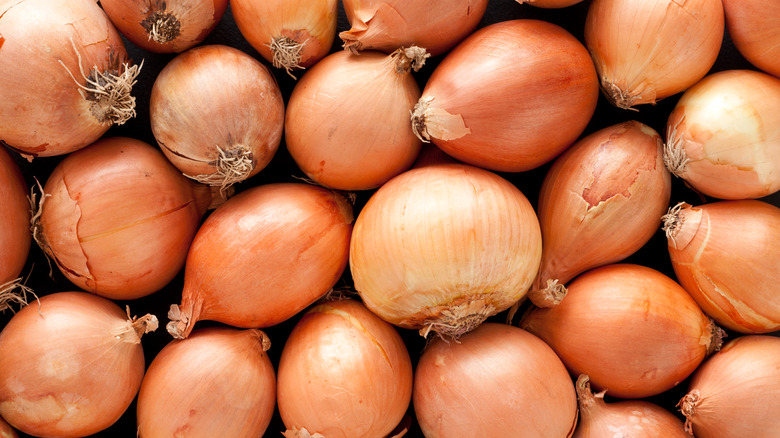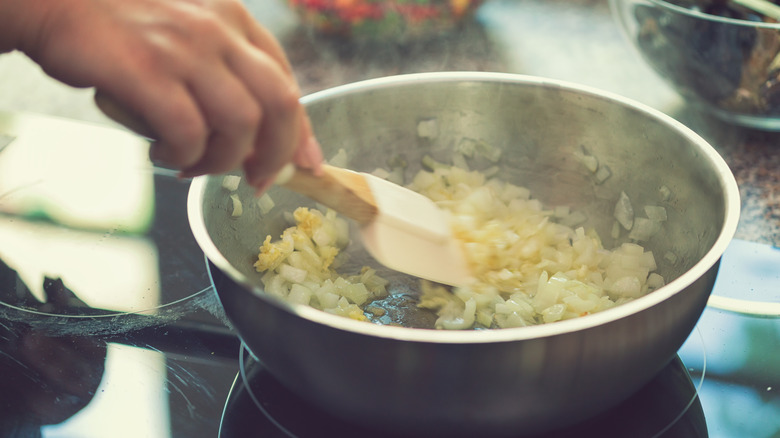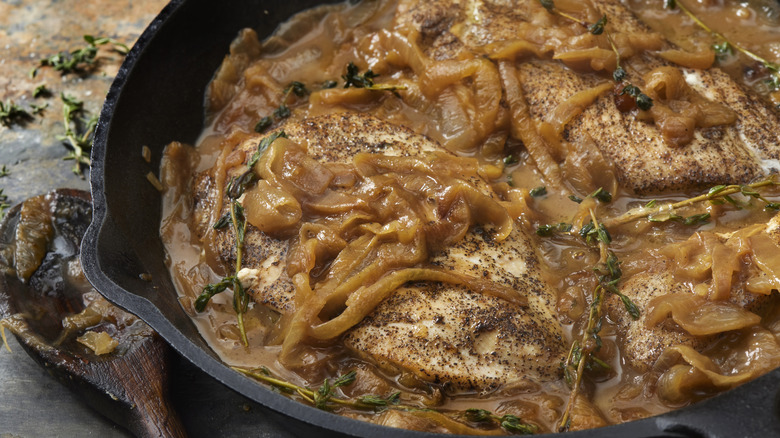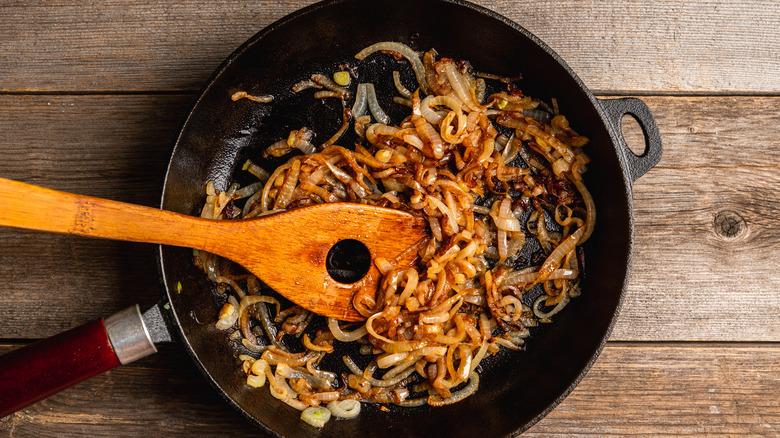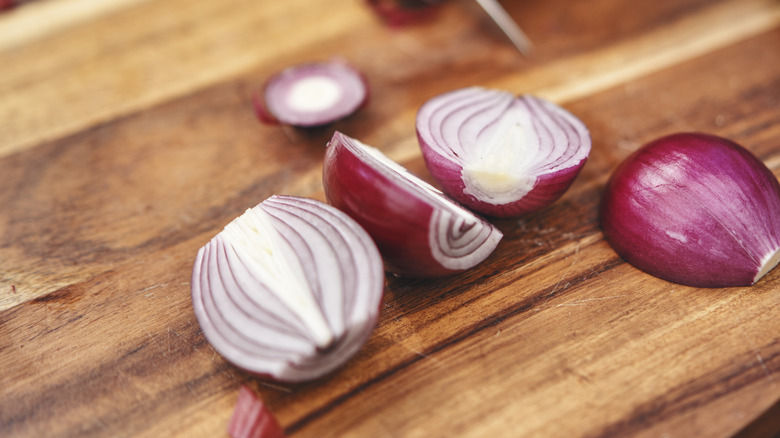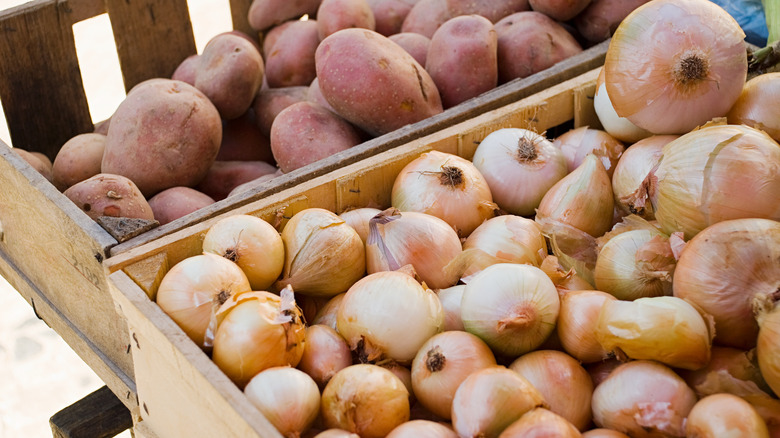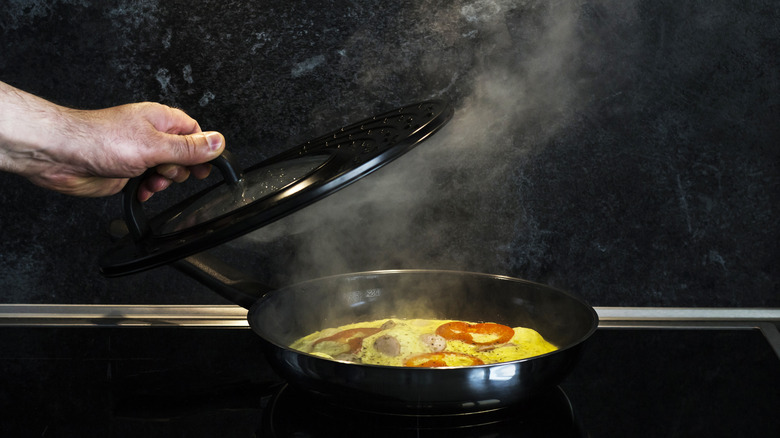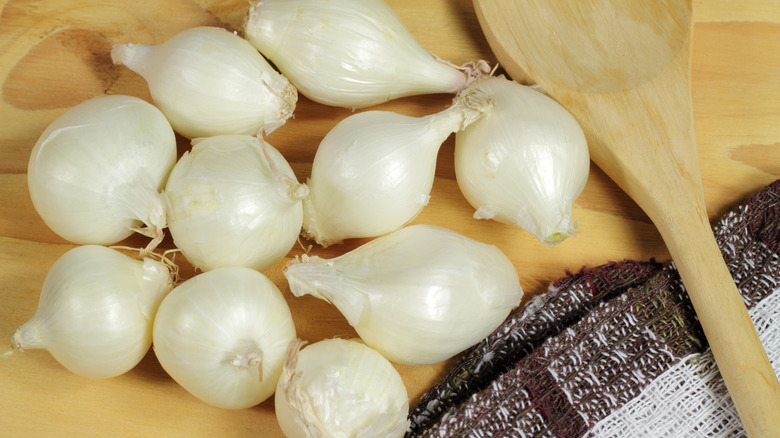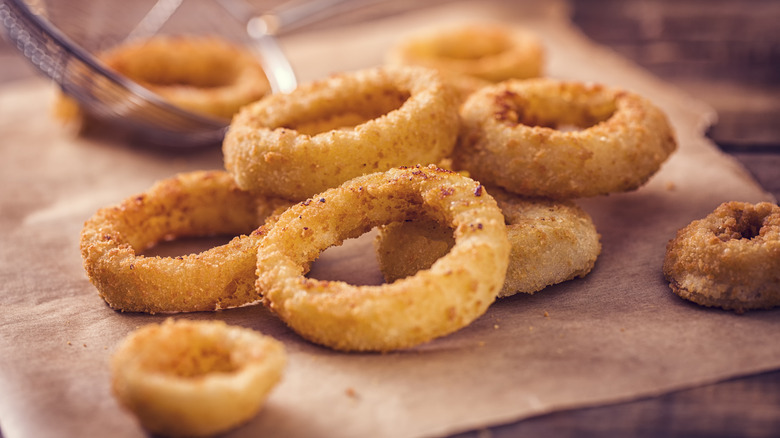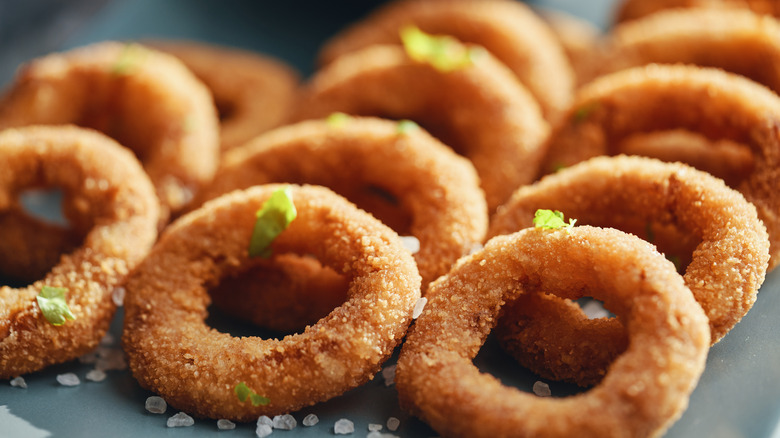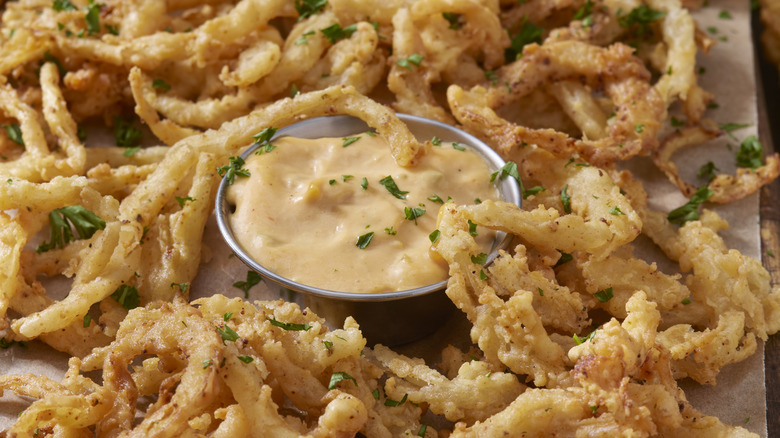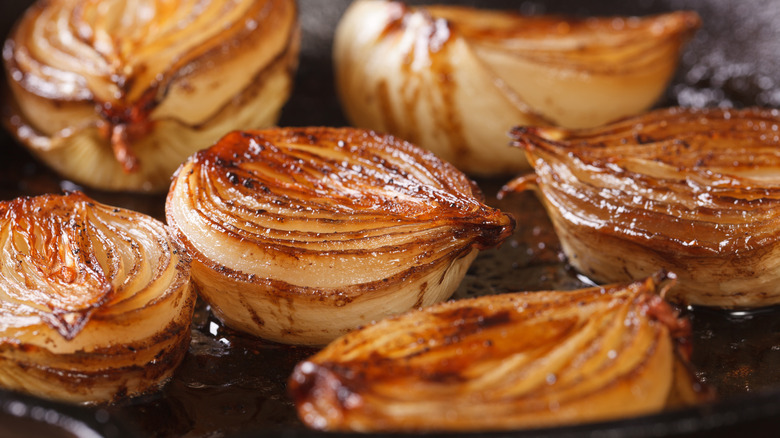11 Techniques For Flawlessly Cooked Onions
Many a memorable feast has started with a simple step: Slicing and cooking a pile of onions. While onions are rarely the star of a meal, they are an indispensable workhorse in many cuisines. It's hard to imagine a braise or stew without them, and few serious home cooks would be caught without a few onions in the crisper, ready to lend their distinctive savory aroma and flavor to whatever's being planned for dinner.
For novice or occasional cooks, however, figuring out exactly how to handle onions can be baffling. What does it mean, for example, to sweat a batch of onions? And why do instructions for sauteing or browning them require anywhere from five to 50 minutes? (And speaking of which, how does one actually brown a batch of onions evenly, with neither scorched nor still-pale bits in evidence?) And on the rare occasions when onions do get a place on center stage — such as in onion rings and creamed onions — why are they such a pain to work with? Fear not. All you need are a few basic tips to cut through the confusion.
Don't confuse browning and caramelizing onions
A term you've probably heard in association with onions is caramelization. Many cooks assume this refers simply to thoroughly browned onions. And while this is a reasonable guess — caramelized onions are indeed deeply browned — they're technically not the same thing as browned onions. And to add to the confusion, they're not technically caramelized, either. While true caramelization involves the exposure of sugar to high heat, the deep browning seen in caramelized onions is actually the result of the Maillard reaction: Browning and flavor development triggered by the interaction of sugars and amino acids.
So what exactly is the difference between browned and caramelized onions? Browned onions are the ones you're probably already making — quickly sauteed over fairly high heat until visibly brown on the outside, but still firm enough to hold their shape. If you've ever had a pile of cooked onions on top of a burger, they were likely cooked this way. Caramelized onions, however, are cooked over low heat until deeply and uniformly browned, a long process that results in the onions softening to a jammy consistency. They develop a deep, rich flavor that makes them an indispensable part of French onion soup and other onion-forward preparations.
When caramelizing onions, give yourself plenty of time
For most weeknight meals, caramelizing onions — that is, slow-cooking them until they nearly dissolve — is definitely overkill. Instead, simply pan-frying them until they soften and develop a bit of color is enough to add flavor and pop to most preparations. It's not only faster, but the sharper flavor and crunchier texture may also be a better match for casual weeknight dishes.
If you do plan to make caramelized onions, however, you need to be fully committed to the process. To get the deep color and rich flavor these onions are known for, you'll need to cook the onions for between 45 minutes and an hour. While the onions don't require constant stirring (leaving them alone for periods of time helps them brown more efficiently), you don't want to walk away from the stove and let them burn, either. And be patient: While the onions may look appealingly golden after about half an hour, they still have a long way to go until their flavors are fully developed. Yes, you'll be standing around the stove for a while — but the payoff will be well worth it.
Use a thick-bottomed pan to protect onions from burning
Onions are among the most humble and affordable of ingredients, and pan-frying them is one of the simplest and most common ways to prepare them. But humble doesn't have to mean boring, and a spoonful of cooked onions can truly elevate a meal — provided they're made with care. Part of that care is keeping an eye on the onions as they cook, stirring them regularly to ensure even browning and avoid burning.
Another step to ensure perfectly cooked onions is to use the right pan — one with a thick bottom. A thick-bottomed pan heats food more evenly since the heat from the stove needs time to spread through the pan's bottom before dissipating into the air. In contrast, thin-bottomed pans may heat up faster, but because heat passes through them and dissipates faster, it doesn't have time to heat up the entire bottom surface evenly. This can lead to hot spots, which can cause your onions to burn or cook unevenly.
To keep cooked onions from falling apart, slice them lengthwise
Most of the time, cooked onions tend to diplomatically dissolve into whatever they're cooked with, contributing their flavor and aroma while allowing other ingredients to take center stage. But onions also deserve to be celebrated on their own and presented whole or in halves can make a lively addition to a platter of mixed grilled vegetables or even the star of a side dish.
For these preparations, you want your onion halves or slices to hold together even after cooking. But as many a cook has discovered, this is easier said than done — the multiple layers comprising an onion seem to want to slip apart if moved. While this speeds up the process when you're chopping onions, it can leave you with a messy pile of onion shards when you're trying to keep pieces intact. To reduce the chance of your onions falling apart on you, an easy trick is to slice them lengthwise — stem to root — rather than crosswise (that is, into rings).
If you want deeply flavored browned onions, avoid sweet varieties
You've probably noticed that cooking onions not only tenderizes them but mellows their flavor, bringing out an appealing sweetness not discernable in most raw onions. If you enjoy the sweet note in browned onions, you might have considered harnessing more of it by using so-called sweet onions, such as Vidalia and Maui onions, which taste sweet even when raw, with none of the bite of regular onions.
In reality, however, this won't do you much good. Sweet onions don't actually have more sugar than regular ones – they simply lack the sulfurous compounds that give raw onions their savory bite, so their natural sweetness is more obvious. And when you're browning onions, the enhanced flavor comes not just from the sugar being heated, but from the interaction of the sugar and these sulfurous compounds, which are largely responsible for the deeply savory notes we associate with browned onions. So save your sweet onions for raw presentations, where their unique flavor can truly shine.
Cover your pan to speed up browning
When you put onions in a pan of hot fat to cook, they undergo a number of changes in succession. The first thing you'll notice, after they've been in the hot pan for a few minutes, is they'll start to release moisture and look wet. If you see a recipe that calls for sweating your onions, this is the stage being referred to. Cooked a while more, they will soften and become translucent as they release even more moisture. Only after this will your onions start to take on some color.
While browning onions is by far faster to do than caramelizing them, it can still take some time if you want them deeply colored. You might be tempted to speed up the process by cranking up the heat, but this can raise the risk of the onions getting burned. A safer and easier way to get your onions to brown more quickly is to simply put a lid on the pan: This will trap and intensify heat and moisture, in effect steaming the onions, helping them continue to brown without drying out and scorching. But because the onions are continuing to brown, keep a close eye on them and stir them regularly to ensure they don't go from browned to burnt.
Peeling pearl onions doesn't have to take forever
Pearl onions — petite bite-size onions no bigger than a ping-pong ball — are beyond adorable, and old-school dishes of creamed or gratineed whole pearl onions continue to be beloved sides on many holiday dinner tables. But while once-forgotten vegetables such as Brussels sprouts and kale have been rediscovered and reimagined by today's cooks, pearl onions have yet to experience such a renaissance. This could be in part because they can be such a pain to prepare: Each tiny little onion must be peeled, and processing dozens or hundreds of them one at a time can be an agonizing bore.
But it doesn't have to be that way; there's an easy way to speed up the process and all it involves is a pot of boiling water and a bowl of ice water. Just dump the onions, skins, and all, into a pot of boiling water and quickly blanch them — this will take about two minutes. (Don't overdo it; you don't want to cook the onions, just to soften up their skins). Drain the onions and submerge them in ice water until they're cool enough to handle. Give each onion a firm squeeze, and it should pop right out of its skin.
When making onion rings, keep your batter cold
Well-made onion rings are not only full of flavor but big fun to eat. Few of us can look at a pile of those golden rings without being tempted to stack them up or twirl one around a finger. And because most of us only enjoy them in restaurants, we associate them with good times out on the town with friends and family.
If you've ever ventured to make them at home, it becomes immediately obvious why most people delegate onion-ring production to professionals — it's messy work. That would be fine if the results were worth the cleanup time, but getting onion rings right is harder than it looks. Among the most frustrating obstacles you'll face is the Teflon-like quality of raw onions: Pick up a raw onion round, dip it into the batter, and half the time, the batter will slip right off. It's seriously annoying. But you can stop this from happening by keeping both your batter and your sliced onions cold. So before frying, refrigerate your batter and chill your onion rounds in ice water. They should stick together nicely.
A dusting of cornstarch will help onion ring batter stick better
Ideally, each bite of an onion ring should contain a perfect balance of rich, crunchy breading and sweet, juicy onion. And, both should come together into a unified whole, ready to be dunked into a cup of ketchup before being popped into your mouth. But even the most ardent onion ring lovers know this happens only half the time — if even that. What's more likely to happen is that big shards of breading will fall from the rings as you bite them. Alternately, you'll end up pulling the cooked onion out of its breaded covering with your teeth, leaving a hollow shell of deep-fried batter to be eaten separately.
Some of this might be unavoidable. But you can help reduce the chances of this happening by dredging your rounds of raw onion in cornstarch before dunking them into the batter. The cornstarch will absorb some of the moisture on the slippery surface of the onion rounds, which will help the batter adhere more effectively, increasing the chances of the coating and onion sticking together when served.
Making your own onion strings is easier than you think
A dressier and even more decadent cousin to onion rings, onion strings are a favorite steakhouse side dish. Like onion rings, these deep-fried tangles of oniony goodness fall squarely into the category of fun food, since the only practical way to eat them is with your fingers. But because they seem to appear primarily in mid-to-high-end sit-down restaurants, they also feel fancy and elegant. The closest thing to onion strings most of us see in home kitchens is the can of fried onions we pour over our green bean casserole.
But we'll let you in on a secret: Onion strings are not that hard to make at home. Indeed, they're easier and more forgiving to make than onion rings. To make them, slice onions into very thin rings or strings (a food processor or mandolin can speed up this process) and soak for at least an hour in buttermilk. Remove them from their buttermilk bath, shake off any excess liquid, and dredge in seasoned flour. Deep-fry in batches of oil heated to 375 degrees Fahrenheit and remove when they turn golden and crunchy, which will happen fast. Drain on paper towels, serve, and bask in the compliments.
A wide skillet makes browning and caramelization easier
When browning or caramelizing onions, you're trying to achieve two things: Besides deepening the color of the onions, you're also working to tenderize them by causing them to shed liquid. But if you cook onions over excessively high heat, they'll brown (or worse, burn) before becoming supple and tender. This is especially problematic when you're trying to make caramelized onions, which are supposed to be velvety soft and browned all the way through.
But while patience is helpful when cooking onions, wasting time isn't. A good way to ensure your time is spent wisely is to use a wide pan to cook your onions. A large surface area helps liquid released by the onions to evaporate quicker and promotes faster browning. In contrast, if you try to cook a large quantity of onions in a pot with a smaller bottom, they may end up steaming in their own juices instead.

